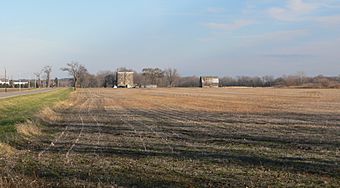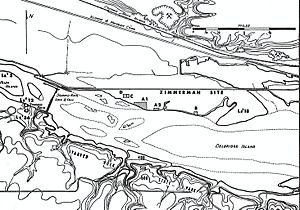Grand Village of the Illinois facts for kids
|
Old Kaskaskia Village
|
|

Old Kaskaskia Village site, seen from the west. Now an archeology site, the village thrived in the late 1600s. In the background left of center is the 1849 Sulphur Springs Hotel. The Illinois River is about 1,000 feet (300 m) south (right) of the road at left.
|
|
| Nearest city | Ottawa, Illinois |
|---|---|
| Built | 1673 |
| NRHP reference No. | 66000324 |
Quick facts for kids Significant dates |
|
| Added to NRHP | October 15, 1966 |
| Designated NHL | July 19, 1964 |
The Grand Village of the Illinois, also known as Old Kaskaskia Village, is a very important historical site. It was a large farming and trading village for Native Americans from the Illinois Confederation. You can find it on the north bank of the Illinois River, close to the town of Utica, Illinois today.
French explorers Louis Joliet and Father Jacques Marquette discovered this village in 1673. The Kaskaskia tribe, part of the Illiniwek people, lived here. Other Illiniwek tribes joined them later. The village grew quickly after a Christian mission and a fur trading post were set up in 1675. It became home to about 6,000 people living in around 460 houses. Around 1691, the Kaskaskia and other Illiniwek tribes moved further south. They left the village because the Iroquois people were invading from the northeast.
Today, the state of Illinois owns this historic site. In the 1940s, a historian named Sarah Tucker from the University of Chicago used old records to figure out where the village likely was. The university and the Illinois State Museum then did archaeological digs. They found lots of evidence that confirmed Tucker's research. Because of its importance, the site was named a National Historic Landmark in 1964.
A famous landmark nearby is Starved Rock. It's on the south bank of the river, right across from the Grand Village site. Another explorer, La Salle, built a fort there to be close to the village. Starved Rock is also a National Historic Landmark and is part of Starved Rock State Park.
Contents
Life at the Grand Village
Archaeological finds show that the Illini people at the Grand Village were very good at living off their land. They grew corn, beans, and squash in the rich soil. In 1673, Father Jacques Marquette and Louis Joliet visited the village. At that time, about 1,000 people lived there. The French explorers were on their way back from mapping the Mississippi River.
Even though he was very sick, Marquette returned to the Grand Village in early 1675. He held a special Mass and started the mission of the Immaculate Conception of the Blessed Virgin. The French called the village both Grand Village du Kaskaskia and La Vantum.
A Growing Community
Around this time, the village became one of the largest Native American settlements north of Mexico. Historian Robert Morrissey believes the Illinois Confederation Indians were smart about their location. They lived in an ecotone, which is a place where two different environments meet. In this case, it was where forests met prairies. This spot was perfect for trading goods between the east and west. It also had many different animals and plants for hunting, farming, and gathering resources.
Challenges and Changes
The Native Americans of the Eastern Woodland culture faced big challenges. European settlers brought new diseases to North America. Native Americans had no natural protection against these illnesses, which caused many deaths. Also, the introduction of guns led to more deadly fights between tribes. The fur trade also caused more competition and conflict.
The Illini Confederacy tribes seemed to come together more closely because of these growing pressures. Reports from La Salle and others in the 1680s show that the Grand Village of the Illini grew even larger. It temporarily housed up to 6,000 people in 400 cabins. However, a village this size was hard to keep going. La Salle and Henri de Tonti also built Fort Saint Louis on the bluff now called Starved Rock, right across the river. A village called Hotel Plaza grew near the base of this rock.
The people of the Grand Village mostly left due to attacks from Iroquois groups during the Beaver Wars. Many likely moved to areas around Peoria (near Fort Pimiteoui), Cahokia, and Kaskaskia, Illinois. These three towns were named after different tribes that were part of the Illinois Confederacy.
Local Stories and Legends
Later European settlers who spoke English didn't fully know what happened to the people of the Grand Village. After the villagers left, a story became popular in local folklore. It said that members of the Illini Confederacy were trapped by enemy tribes on top of Starved Rock. Surrounded and without hope, the brave villagers refused to give up and supposedly died of starvation. This is how "Starved Rock" supposedly got its name.
The Tale of Tonti's Gold
One story, told by both the French and Native Americans, is about the explorer Henri de Tonti. It says he hid a lot of gold near the canyons and bluffs of Starved Rock. He wanted to keep it safe from a French Canadian governor who had fired him. Later, in 1704, when Tonti was dying from yellow fever, he told the priest giving him last rites where the treasure was. The story goes that the priest mentioned this secret to others but didn't say where the gold was. This important information was lost when the priest died in a canoe accident on the Illinois River.
The Story of Pontiac
Another story is about the death of Pontiac in 1769. He was killed by an unnamed member of the Illini Confederacy. According to this tale, the Pottawatomi, who were close allies of Pontiac's family, went to war against the Illini. They forced many Illini to hide on the bluff that became known as "Starved Rock." The Illini supposedly starved because their refuge on the bluff was surrounded.
The Site Today
The state of Illinois bought the Grand Village of the Illinois site in 1991. It is managed by the Illinois Historic Preservation Agency. As of 2018, the site is not open to the public.
The Zimmerman Site
The Zimmerman Site (Ls-13) is an important archaeological spot. It's located on the Illinois River right across from Starved Rock. This is the exact place where the Grand Village of the Kaskaskia (also called the Grand Village of the Illinois) once stood. It's a "multi-component" site, meaning it has evidence from both Prehistoric times and early Historic periods.
During Prehistoric times, the area around the Zimmerman site was mostly prairie. The bluffs along both sides of the Illinois River were covered in oak forests. The low-lying lands near the river had plants that liked wet areas, like willow, maple, ash, and cottonwood trees.
Early French explorers like Joliet, Marquette, Allouez, and Tonti visited the Grand Village of Kaskaskia between 1673 and 1680. The Kaskaskia were a part of the Illiniwek Confederacy. Other Illiniwek groups, like the Peoria, Tapouaro, and Coiracoentanon, also lived at the site. Later, other tribes such as the Miami and Shawnee were present there. In the fall of 1680, an Iroquois war party burned the village, and it was then abandoned.
Finding the Village: Archaeological Digs
In the 1940s, Sara Jones Tucker from the University of Chicago started a project. She wanted to find the exact location of the Kaskaskia village by looking at old French records. Her hard work led to the discovery of the Zimmerman site.
In 1947, the site was excavated, which means archaeologists carefully dug it up. This work was done by the Illinois State Museum and the University of Chicago. They divided the area into four sections, called Grids A, B, C, and D. Later, from 1970 to 1972, more digs happened. These were led by the LaSalle County Historical Society in Utica, Illinois. These later excavations focused on Grids A and B to get more information and answer questions from the first project.




